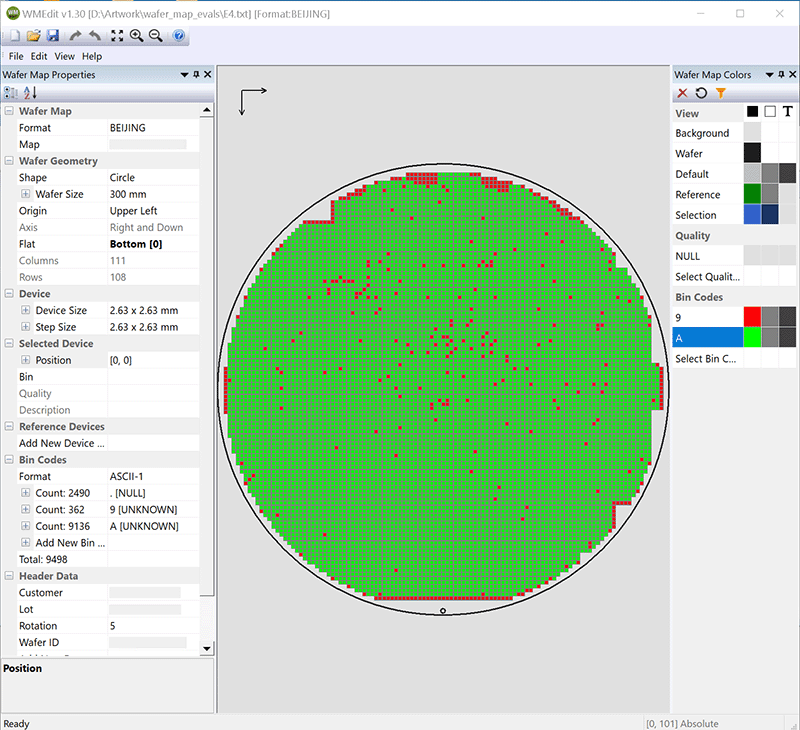

We call this map format Beijing because the sample files provided by our customer originated from Beijing, China. We have no other information about this format other than the sample provided. Should anyone recognize the source of this file (either by foundry, specification, test software ... please drop us a note.
Header
Customer: XXXXX string with the customer name Lot:9000000 lot number Wafer ID:1-0000000-13-E4 wafer ID Die Size X,Y: 2.630,2.630 die size (units seem to be mm) MaxXY: 111,108 row/column count Rotation: 5 flat location? 5 makes no sense Wafer Size: 300 wafer diameter in mm Total Die: 9498 total die tested Passed: 9136 total die passed
That's it for the header. No information about reference die; no bin codes or bin attributes such as pass/fail.
The rotation likely refers to the position of the notch on the wafer but the number "5" does not make sense to us. Typically there are 4 notch locations (top, bottom, left, right) and either 0-3 or 1-4 can be used.
Map Section
The header is followed by the map. An empty line between end of header and start of map data was noted in the sample.
..............................................99999999AA ..........................................999A99999999AA ......................................9AAAAAAAAA999999AA ...................................9AAAAAAAAA9AAAAA9AAA9 .................................999AAAA9AAAAAAAAAAAAAAA ...............................9999AAAAAAAAAAAAAAAAAAAAA .............................999AAAAAAAAAAAAAAAAAAAAAAAA ...........................9AAAAAAAAAAAAAAAAAAAAAAAAAA9A ...........................9AAAAAAAAAAAAAAAAAAAAAAAAAAAA ...........................9AAAAAAAAAAAAAA9AAAAAAAAAAAAA ...........................9AAAAAAAAAAAAAAAAAAAAAAAAAAAA ...........................9AAAAAAAAAAAAAAAAAAA9AAAAAAAA ....................99999999AAAAAAAAAAAAAAAAAAAAAAAAAAAA ...................AAAAAAAAAAAAAAAAAAAAAAAAAAAAAAAAAAAAA ..................AAAAAAAAAAAAAAAAAAAAAAAAAAAAAAAAAAAAAA .................AAAAAAAAAAAAAAAAAAAAAAAAAAAAAAAAAAAAAAA ................AAAAAAAAAAAAAAAAAAAAAAAAAAAAAAAAAAAAAAAA ...............AAAAAAAAAAAAAAAAAAAAAAAAAAAAAAAAAAAAAAAAA ..............9AAAAAAAAAAAAAAAAAAAAAAAAAAAAAAAAAAAAAAAAA .............9AAAAAAAAAAAAAAAAAAAAAAAAAAAAAAAAAAAAAAAAAA ............9AAAAAAAAAAAAAAAAAAAAAAAAAAAA9AAAAAAAAAAAAAA ............AAAAAAAAAAAAAAAAAAAAAAAAAAAAAAAAAAAAAAAAAAAA
Based on this sample we make the following assumptions:
"." indicates a null or skip position in the array
"9" indicates a fail device
"A" indicates a pass device
And below is how WMEdit shows the results. For this map data it is pretty clear that the notch/flat is on the bottom. The user has to assign colors to each bin code to achieve this same colored view.
Notice that the number of "A" bin codes reported by WMEdit matches the header's Passed: value and the total of bin code "9" and bin code "A" match the header's number of total die.
